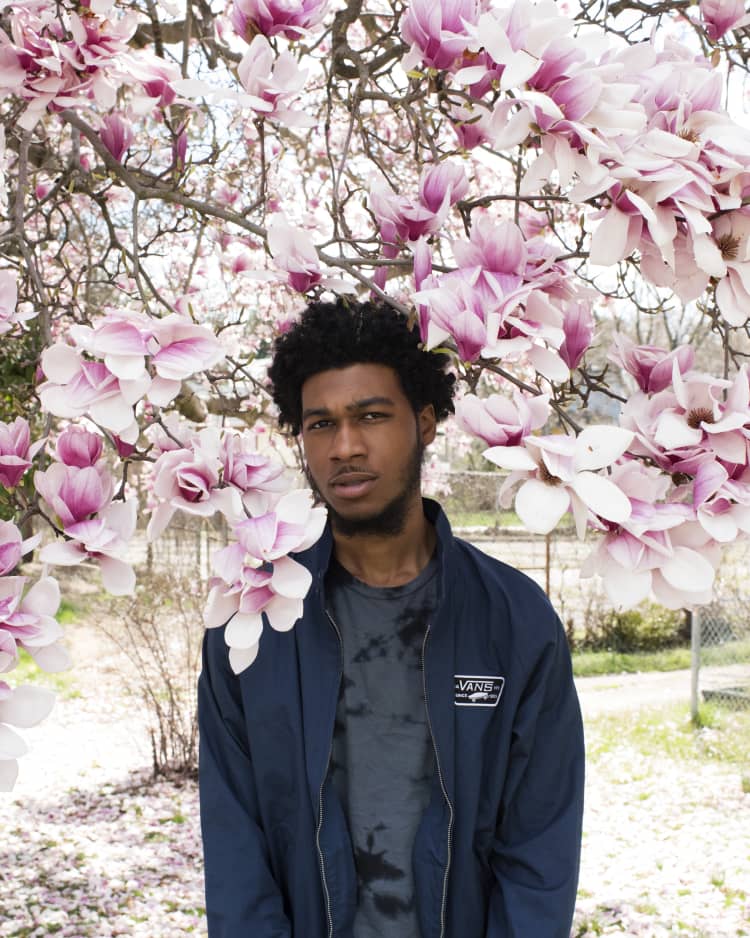These Zines Are Some Of The Most Important Things Happening Offline Right Now
Creators of True Laurels, Hidden Eye, and Sula Collective share their processes.

The internet is full of emerging platforms for expression, but zines still embrace the value in real life output. During a time where information is shared quickly and is sometimes impermanently, Zines create long lasting spaces for content tailored to specific audiences. The FADER spoke to three important creators about what each of them want to inspire in their readers, what's hard about publishing a zine, and what's special about making tangible things.
Writer and Baltimore native, Lawrence Burney came up with True Laurels to give an intimate look into the dynamic of his hometown through rich photos and inside access to the city's culture. Carson Cox, a member of the band Merchandise, started his zine, Hidden Eye with a dedication to featuring content that Cox feels is relevant and necessary. Young women, Kassandra Piñero and Sophia Yuet See, created a Sula Collective—a zine that started out online but has now expanded through IRL relationships. It's devoted to being a platform to display the art and talent of young people of color.
True Laurels
Why is it important to do things offline right now?
LAWRENCE BURNEY: I wanted to step away from [social media] and see the things that I would put together if I was in control. If it was just all me. I want to share the shit that I like with people, especially when it comes to music. Most of the stuff I write music wise is about people who aren’t super well-known. When I’m around people that I don’t know or I do know I’m like, “Yo, did you hear this person’s work?
What is your zine in particular trying to achieve?
BURNEY: It’s going through a couple of phases. At first, when I started making it, it didn’t have any focus to be honest with you. I had an idea to make this little magazine. I reached out to people I liked and just wanted to see what I could do with it. I was printing it at home on a laser jet printer and just going to FedEx and binding it. Since then, the reason why I wanted to do it and why it’s important to me is, there are alot of people in Baltimore that I feel like are very gifted. A lot of these people don’t know how to move to get their stuff out to bigger audiences or they might feel intimidated or they got burned by somebody a couple of times or whatever the case may be. I just think that I can highlight the things that are around me. That gives me the upper hand on any other journalist or writer that just writes about what they see in a press release. I can do good by Baltimore by my peers and people that want to get out there and be recognized and encouraged. A lot of people I know have quit along the way because they didn’t feel valued.
How does Baltimore inspire those stories you want to tell?
BURNEY: What went down during The Uprising inspired me. That was a very weird time for me because although I have a thorough understanding of how things work, socially and economically, that didn't save me from being borderline shaken up emotionally. I saw neighborhoods I grew up in burn as I drove past that Monday night when the official unrest started. When I thought of why we acted out that way, it was because of being so frustrated and mad about having our stories and issues be overlooked forever. Right before then, I was planning on having less local artists in True Laurels because I was starting to feel shame and discouragement about being the "Baltimore guy."
I thought no one would care about shit that goes on here plus I was really feeling the pressure of being popular. Although I definitely want widespread recognition for my work, I couldn't stomach me doing the same thing to my own city that had us so enraged in the first place like being ignored, overlooked and devoid of faith. If I don't like others doing that to Baltimore, then I shouldn't do it either. The Uprising enhanced my pride in Baltimore. I already had it, but because of last year, I feel purpose in my pride.
It inspires me because I know what it takes to live in this city. I know the struggle that people go through with their self-confidence and feeling like that can’t make it because they’re from here. I felt like that probably all the way up until two years ago. But, I know that was because of what I was thinking. It wasn’t because somebody was making me. Once I realized that Baltimore is more of an advantage than a hinderance, better things started happening for me.
Who all is involved in making it?
BURNEY: I have a team of people that work with me. I would say that I’m the overseer of things. I conceptualize most of it. This past issue, I’d actually won a grant in Baltimore this past month, which gave me the opportunity to pay people and that’s what I’ve really been wanting to do since the beginning. Now I can actually commission photographers and pay the writers that I recruit. It just makes it a way better experience. I don’t like to do anything for free so now that I can pay people I know that they’re going to give their best work. Mainly it’s me, but I have two friends who lend their hand when they can. I also reach out to people and I’m like, “I really like your writing. Would you be down to do something for my zine and I pay you?”
Is it hard to make?
BURNEY: For money reasons yeah, it’s hard as fuck. I was printing at home and it was black and white. Now that I’m trying to do more with it and go bigger that’s what makes it hard. It’s not the ideas. It’s not the lack of material. It’s just money that makes it hard but the improvement is so amazing. The shit looks like a real magazine now.
How often do you publish?
BURNEY: I’ve produced seven zines but this one is the first real print issue so I’m calling it number one. Now, that I have some money for operations, I’m going to do it quarterly. So I can have the time to get the the information and now I have the photographers that I want to work with. That’s what I was able to put an emphasis on this time around. I worked with Shane Smith, Audrey Gatewood, and a guy named Ellis Marsalis III. He’s one of my friend’s father from where we grew up on the East side of Baltimore. His father took photos of the kids on our block from 1988 to about 2004. The pictures are amazing and you can see all the shit that people go through, people dying, kids having guns. I’m most proud that I could give the guy who documented my whole block when I was younger the opportunity to be a part of it.
What have you learned about the process?
BURNEY: I’m learning that what’s really pulling people to the magazines is the imagery. So, I had to realize that I have to have amazing photos. The writing is the icing on the cake. I’ve learned that being patient and taking your time is the most important thing that you could do. At first, I was so concerned with it being bi-monthly that I was just putting anything out. It’s a shame because I have a lot of friends that make good music and I knew super poppin people from the beginning but just because I was rushing, I was just putting anything out. So just respect the process.
Hidden Eye
Why is it important to do things offline right now?
CARSON COX: I don’t know what is important. I only know what is personal. Everything is undervalued in American society, especially art or original artists. All major media outlets ignore original work or the forum doesn’t work. This is a small forum and maybe does things better because it’s small. Being offline keeps it hidden.
What is Hidden Eye trying to achieve?
COX: Nothing.
What inspires the types of stories you tell in Hidden Eye?
COX: Real ideas. It’s inspired by life, not celluloid. It may be a crude interpretation but it’s meant to be imperfect.
Why did you launch it?
COX: To try to escape the void of shit and boring garbage. Most magazines are all paid advertising. No one is getting paid so it gives us an edge.
Who all is involved in making it?
COX: Cultural anarchists of the non political variety. Political art maybe appear from time to time but the mag is meant to cover all areas without taking a side.
Is it hard to make?
COX: It was very very very hard. I hope the next issue is easier but I’m not here to try to do easy stuff.
How often do you publish?
COX: When God allows it.
What have you learned about the process?
COX: That success is personal. Art is personal. Life is personal. That being your own voice in the world is something anyone can do.
Sula Collective
Why is it important to do things offline right now?
KASSANDRA PIÑERO: I’ve only just recently started branching outside of my small online bubble and actually attending events in person a few months ago. I had no idea that so many cities were full of free events specifically created for people of color. Doing things offline definitely instills a greater sense of belonging and community in your personal life which is so important for artists/writers of color. I don’t think I would have the confidence and trust in myself I have now if it weren’t for the validation of other creatives of color struggling with the same insecurities.
SOPHIA YUET SEE: I think online spaces have been very important for us and, of course, our generation as a whole due to the way the internet has influenced our aesthetics, thoughts, feelings, and movements. This is why we originally made Sula Collective with the intent of it being an online platform only because it is a relatively accessible space. However, one thing that has come out of internet connections and friendships, is the transformation of URL relationships to IRL relationships. At Sula Collective, we are slowly looking at ways in which we can shift our online presence into physical spaces or interactions, whether that’s through artist collaboration or events and meetups around the world for example.
What is your zine in particular trying to achieve?
BOTH: It is a celebration of people of colour. We want to achieve a feeling of community amongst us. Some may feel alienated by academia or may never get the chance to meet in person due to distance or lack of funds but we try to give people a platform where they can meet potential collaborators and receive criticism that comes from a place of mutual understanding. We wanted this to be a space of healing and freedom where we could be surrounded by people who understand our work without having to whitewash it under the guise of making it more “accessible."
What inspires the types of stories you tell in Sula Collective?
YUET SEE: Our stories are informed by our own experiences. Our storytelling, whether it be through art, poetry or music, is often a form of survival, a way of healing, to make everything softer as we navigate a world that is sometimes more challenging or painful than it should be.
PIÑERO: The very important need for representation in creative communities. Too often we are reduced to people who are considered less pure and less human than white people. Our stories are without a doubt created by the need to navigate the pain we experience, but our stories are also here to allow others to connect with art in a way they can’t within mainstream media. I remember when I was growing up I didn’t think people of color could create art or write because I had never been exposed to my people doing those things, so it feels good to know that there are teenagers browsing our site and finding poetry or photography that is created by and for PoC that they can relate to.
Why did you launch it?
BOTH: We, Kassandra and Sophia, curate, edit, and publish the content on Sula Collective, and we’re supported by a main team who help us think up new ideas on how to expand Sula and create more original content. We also have an amazingly talented staff of writers, illustrators, photographers and more who contribute monthly and are a huge part of the reason Sula has made it this far.
Is it hard to make?
BOTH: I’d say yes and no. Since we are a website and not a print publication (yet), it makes things a lot easier on us because formatting isn’t complicated and neither is editing. Things can get pretty stressful when we don’t have enough illustrations for the massive amounts of writing we receive or when we’re short on submissions for an issue, but once you get past the first couple of months you learn to work your way around things and become very good at improvising.
YUET SEE: Starting an online project is not as difficult as it may seem. We’ve lucky to have a great team who have been with us since the beginning, they even chipped in a few dollars to help get us started. They continually create interesting content for us and the zine wouldn't be the same without them. Because I'm still at school it has been difficult to juggle Sula with studies, exams and uni applications, but there is always someone else in our staff who steps up when one of us needs to step down for a while.
How often do you publish?
BOTH: We used to publish monthly, but we’ve been experimenting lately and issues posted on our website are currently bi-monthly with one post being published daily. The month in between issues is being used to experiment with other potential mediums for Sula to branch out into.
What have you learned about the process?
BOTH: Perseverance is key. We’ve learnt how much dedication is needed for a project like Sula. It has definitely been worth it as we’ve also learned how strong a community can be and how much others supported Sula even though they had never met us before. Solidarity is very real in these communities and so far we have received non-stop love. Don’t be afraid to reach out to people who are “bigger” than you, because more often than not they are more than willing to help.




